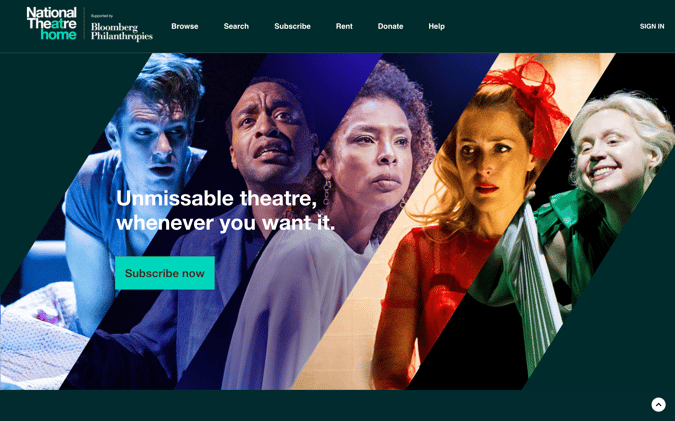Adapting to change
The arts and cultural industry is undergoing a profound digital transformation. This has only been accelerated by the Covid-19 pandemic, which forced many organisations to shift from physical to virtual experiences. In this blog post, we explore five organisations that are adapting their ways of working to drive long term success – far beyond the lifting of pandemic restrictions.
1) How Opera North created new revenue streams with a virtual choir
Opera North is a national opera company based in Leeds. While being rooted in the North of England, Opera North is international in outlook, with the goal of using music and opera to entertain, engage, challenge and inspire. Like many arts organisations, the pandemic brought a range of challenges: maintaining contact with its audience, continuing to create music, and staying afloat financially.
The idea of a virtual choir came from Opera North’s ‘Sing ON’ work, a series of weekly in-person singing workshops for over 55s in the Leeds area. When lockdown hit, the team decided to experiment with a virtual session – and decided to open this opportunity beyond the original audience.
Jenny Sterling, the choir’s presenter, told Backtrack magazine: “I said to my boss, it's such a shame these sessions are stopping for the summer. It'd be lovely if we could give our participants something to keep going. We could maybe open up to a few extra people.”
The virtual choir, known as ‘From Couch to Chorus’ became a space where anyone can learn to sing opera choruses via Zoom. The Opera North team wanted to make the choir accessible to all – so rather than charging a fixed price for these sessions, they experimented with a ‘pay-what-you-feel’ model. Along the way, Opera North took a data-driven approach to optimise adoption. This included A/B testing different messaging on the website, and determining the optimal time to send emails in order to maximise open and click-through rates.
Opera North has seen great success from the programme – with 5,000 unique bookers from all over the world taking part, with 48% of these people being new to the organisation.





2) How the Hermitage Gallery is increasing engagement with a digital twin in the Metaverse
The State Hermitage Museum in Saint Petersburg is the largest art museum in the world by gallery space. Established in 1764, it is perhaps a surprising contender for pioneering experiments in the metaverse and NFTs. But Dmitry Ozerkov, the head of the contemporary art department, believes that all museums will eventually build their digital copy in the metaverse.
In Spring 2021 the traditional art world was rocked when Christieʼs auction house sold the artist Beeple’s work Everydays: The First 5000 Days for a record $69.3 million. The Hermitage were quick to take advantage of growing engagement in web3 technologies, and in September launched their first NFT experiment. Five digital reproductions of its most famous masterpieces were released as NFTs. The sale raised almost $450,000.
Then, in November 2021, the Hermitage opened the (virtual) doors to its first purely digital exhibition: “The Ethereal Aether”. Building on the concepts of the metaverse, a digital twin of a museum space was built. Within this virtual space, a two month exhibition showcased 38 NFTs that visitors were able to interact with. In a video interview with Cointelegraph, Ozerkov speaks about the possibility of this new space compared with a traditional gallery experience: "You can pass through these doors without touching anything, while in the virtual world, you can do anything: you can play with artworks, you can make them interactive, you can add data to it", explained Ozerkov.





This exhibition marked the first step in creating the “Celestial Hermitage”. According to the gallery, this is “a new museum in the virtual noosphere, which in future will be transformed into a digital branch of the actual museum”
While the metaverse and NFTs may not be the right approach for every organisation, the cultural sector is often uniquely placed to lead on future technologies. The Hermitage provides a great example of the kind of payoff that’s possible when an organisation adopts an open and experimental approach.
3) The Black Country Living Museum reached new audiences by becoming the most followed museum on TikTok
The Black Country Living Museum (BCLM) is a 26-acre open air museum that recreates one of the first industrialised landscapes in Britain. Like many cultural institutions, it was hit hard by lockdown. In the twelve months following the 2020 lockdown, visitors were down from a typical 350,000 to 90,000 – leading to losses of £5.5m. Most of the 270 staff at BCLM were furloughed, and volunteers were unable to lend their usual support. This meant that many of the actors who were used to performing historical characters were left without a role to play
BCLM Communications Manager Abbey Bird saw the potential to translate many of these skills to the online domain, and BCLM became the first UK-based museum to join TikTok “Our actors know how to tell stories really well”, she told Museum Next. One early hit was John Homer’s flat-capped 1920s Grandad, who provided age-old wisdom in fireside videos. By summer 2021 his chats had amassed over 22m views worldwide.
More comedic content was tested too, with one video seeing a Victorian pharmacist happily dancing down a cobbled street to Lana Del Ray, full of energy after “a long day of selling lethal doses of arsenic to angry housewives”
The TikTok channel has reached 30million people globally and currently has 1.3million followers. The vast majority of followers are people under 30, many of whom had never interacted with a museum on social media before. And now that the museum’s doors have reopened, there has been an increase in young people visiting – which BLCM attribute to their new-found TikTok fame.
BCLM’s story shows how important it is for all arts organisations to experiment with new channels, and take a data-driven approach to testing their effectiveness.
4) How digital portals like Digital Theatre and NT at home are cementing the role of digital subscriptions in the theatre world
There’s nothing particularly novel about offering performances as streaming content – New York’s Met Opera launched its on-demand service way back in 2012. But the pandemic has grown the audience for this type of content, and we’re seeing a rise in those offering digital subscriptions to access it.
During the first months of the 2020 lockdown, The National Theatre began to offer weekly on-demand streams available to enjoy for free on YouTube. And by later in the year, this had evolved into a new streaming platform: National Theatre At Home. Live and archive content is available, with options to rent or take out monthly/annual subscriptions. There has been some smart bundling too: National Theatre Digital+ Membership includes a National Theatre at Home subscription, plus exclusive events, backstage content, news and priority booking for live in-person shows.
Meanwhile services like Digital Theatre Plus have shown the potential to make this sort of content available in a B2B setting. This streaming service is targeted specifically at educational institutions, and offers a collection of over 1000 full-length films of plays, modern dramas, classical music, dance, musicals, opera and adaptations of classic novels. Bundled with the content itself are teaching and learning resources designed to help students engage more deeply with the productions. These resources include plot summaries, character biographies, relationship maps, language analysis, performance background and historical context for each play.
Over the past few months, we’ve been fascinated to see that many of the initiatives that drive success of news subscriptions overlap with the emergent cultural subscriptions market (e.g. annual pricing options, gift subscriptions). We believe that every arts organisation should consider whether these models could unlock additional value for their audiences.





5) How London music venue Koko is reimagining its business model with a new membership scheme
Disaster hit music venue Koko just months before the pandemic struck, with a fire ripping through its roof in January 2020. At the time, work was already well underway to transform the London venue into a “world-class music and hospitality destination”.
Despite the setbacks, Koko is preparing to open its doors once more in Spring 2022. Extensive physical restoration will open up entirely new spaces in the venue, including a recording studio, piano room, library, hidden speakeasy, stage kitchen and vinyl rooms. On top of that, the venue is looking beyond physical possibilities, and is integrating hi-spec live-streaming capabilities throughout the venue.
“When I started this project back in 2015, I think streaming was just beginning to break through,” CEO Olly Bengough told Evening Standard. “And what I thought was that, actually, there was going to come a day where the lines will be blurred, and anyone who loves music is going to want to experience it whether that’s in a venue or at home.”
Details are beginning to emerge of an “innovative membership offering” that will seek to activate a creative community in both the physical and digital worlds. At FT Strategies, we can see much potential in a hybrid in-person/online membership business model. Koko provides a great example of an organisation that has seen the potential of this hybrid world even before the pandemic struck. While this exact business model may not be right for your audience, it is worth considering how you can build a deeper relationship with your audience across the physical and digital worlds.
About the author





Aled has over eleven years’ experience in the media, overseeing strategy, product, new venture creation and editorial. Previously he was Head of Membership Strategy and Business Development at Condé Nast, where he launched their B2B subscription title Vogue Business. Aled cut his teeth in TV news at ITN and later received his MBA from Cambridge University. Outside of the day job, his kids keep him busy and he is also a trustee and director of DeliverAid, a charity helping those suffering from food poverty started during the pandemic.
